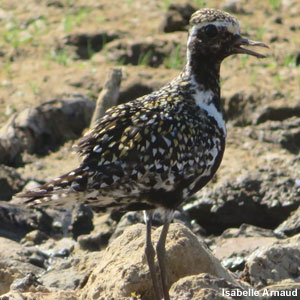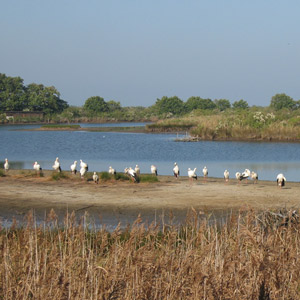Pratique | Identification
Distinguer les Pluviers fauve et doré adultes en plumage nuptial

Pluvier fauve (Pluvialis fulva) adulte en plumage nuptial, lac du Bourdon, Saint-Fargeau (Yonne), le 25 août 2019 : notez le bec assez long, les longs tibias, les motifs jaunes et noirs assez « grossiers » sur le manteau et le dessus des ailes, la courte projection primaire et la grande étendue de noir sur les flancs et les sous-caudales.
Photographie : Isabelle Arnaud / Sa page Facebook
Introduction
Internet a des défauts, mais il facilite aussi la diffusion et l’échange d’informations, ce qui est très utile pour les observateurs. Le 25 août 2019, sur les rives du lac du Bourdon à Saint-Fargeau (Yonne), Isabelle Arnaud avait ainsi découvert et photographié un limicole qui ressemblait à un Pluvier doré (Pluvialis apricaria) adulte. Le lendemain, elle a publié une photo de cet oiseau sur notre page Facebook pour avoir d’autres avis, et un observateur confirmé a reconnu un probable Pluvier fauve (Pluvialis fulva), une espèce originaire du nord de la Sibérie et de l’ouest de l’Alaska très rare en Europe. Une visite sur place lui a permis de confirmer cette identification (en particulier ses aisselles grisâtres), et l’oiseau a ensuite été vu et photographié par d’autres observateurs.
Le 9 août 2016, dans la réserve ornithologique du Teich (Gironde), Dominique Tissier avait aussi repéré un intéressant pluvier adulte très confiant en plumage nuptial entamant sa mue postnuptiale : les avis de plusieurs observateurs sur le site web Faune-aquitaine.org lui ont permis de confirmer qu’il s’agissait d’un Pluvier fauve.
Grâce aux photos de ces deux oiseaux prises par Didier Leveau, Thomas Marchal, Isabelle Arnaud et Jean-Paul Leau, nous vous proposons une comparaison des Pluviers fauve et doré adultes en plumage nuptial et nous recensons les critères permettant de les distinguer.
Abstract
The Internet has flaws, but it also facilitates the diffusion and exchange of informations, which is very useful for birders. The 25th of August 2019, on the banks of the lac du Bourdon, near Saint-Fargeau (Yonne, France), Isabelle Arnaud discovered and photographed a wader that looked like an adult Eurasian Golden Plover (Pluvialis apricaria). The next day, she posted a picture of this bird on our Facebook page for further advice, and a confirmed birder identified it a probable Pacific Golden Plover (Pluvialis fulva), a much rarer species in Europe coming from northern Siberia and wetern Alaska. A visit in the fied confirmed this identification, and the bird was then watched and photographed by other birders.
The 9th of August 2016, in réserve ornithologique du Teich (Gironde, France), Dominique Tissier also found an interesting adult and very confident plover in breeding and moulting plumage. He published his observation on the Faune-aquitaine.org website and several birders confirmed that it was a Pacific Golden Plover.
Thanks to the photos taken by Didier Leveau, Thomas Marchal, Isabelle Arnaud and Jean-Paul Leau, we propose a comparison of the Eurasian and Pacific Golden Plovers in breeding plumage and we identify the criteria to distinguish them.
Poursuivez la lecture de cet article, en vous abonnant dès maintenant !
Découvrez les Archives d’Ornithomedia.com
Pour seulement 10,00 €TTC/an (ou 6,00 € les 6 mois)
Profitez de plusieurs centaines d’articles en accès illimité et sans aucun engagement.
Compléments
À lire sur le web
- Le site web de la réserve ornithologique du Teich : www.parc-ornithologique-du-teich.com
- Le site web collaboratif www.faune-aquitaine.org
- le site web de l’office de tourisme du bassin d’Arcachon : www.bassin-arcachon.com
- Le site web du Comité d’Homologation Nationale : www.chn-france.org
Ouvrages recommandés
- Guide des oiseaux du bassin d’Arcachon de Claude Feigné
- Autour du bassin d’arcachon à vélo et à pied de Claude Feigné et Brigitte Durgeon
- Le guide Ornitho Killian Mullarney et al
- The Handbook of Bird Identification: For Europe and the Western Palearctic de Mark Beaman, Steve Madge
- Guide des limicoles d’Europe, d’Asie et d’Amérique du Nord Stephen Message et Don Taylor
Sources
- Mark Beaman et Steve Madge (2010). The Handbook of Bird Identification: For Europe and the Western Palearctic. Pacific Golden Plover. Pages : 308-309.
- Alvaro Jamarillo (2004). Featured photo identification of adult Pacific and American Golden Plovers in their southbound migration. Western Birds. Volume : 35. Pages : 120 – 124. www.researchgate.net





Aucun commentaire sur ce sujet
Participer à la discussion !